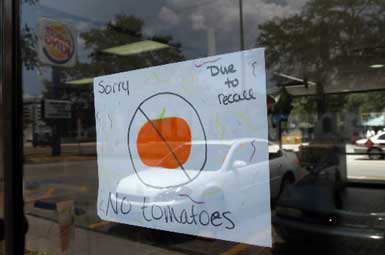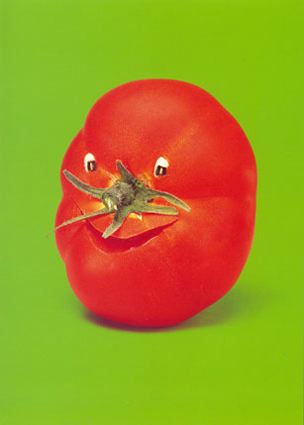The U.S. Food and Drug Administration is expanding its warning to consumers nationwide that a salmonellosis outbreak has been linked to consumption of certain raw red plum, red Roma, and red round tomatoes, and products containing these raw, red tomatoes.
.jpg) FDA recommends that consumers not eat raw red Roma, raw red plum, raw red round tomatoes, or products that contain these types of raw red tomatoes unless the tomatoes are from the sources listed below.
FDA recommends that consumers not eat raw red Roma, raw red plum, raw red round tomatoes, or products that contain these types of raw red tomatoes unless the tomatoes are from the sources listed below.
If unsure of where tomatoes are grown or harvested, consumers are encouraged to contact the store where the tomato purchase was made. Consumers should continue to eat cherry tomatoes, grape tomatoes, and tomatoes sold with the vine still attached, or tomatoes grown at home.
On June 5, using traceback and other distribution pattern information, FDA published a list of states, territories, and countries where tomatoes are grown and harvested which have not been associated with this outbreak. This updated list includes: Arkansas, California, Georgia, North Carolina, South Carolina, Tennessee, Texas, Belgium, Canada, Dominican Republic, Guatemala, Israel, Netherlands, and Puerto Rico. The list is available at www.fda.gov/oc/opacom/hottopics/tomatoes.html#retailers. This list will be updated as more information becomes available.
FDA recommends that retailers, restaurateurs, and food service operators not offer for sale and service raw red Roma, raw red plum, and raw red round tomatoes unless they are from the sources listed above. Cherry tomatoes, grape tomatoes, and tomatoes sold with the vine still attached, may continue to be offered from any source.
Since mid April, there have been 145 reported cases of salmonellosis caused by Salmonella Saintpaul nationwide, including at least 23 hospitalizations. States reporting illnesses linked to the outbreak include: Arizona, California, Colorado, Connecticut, Idaho, Illinois, Indiana, Kansas, New Mexico, Oklahoma, Oregon, Texas, Utah, Virginia, Washington, and Wisconsin. Salmonella Saintpaul is an uncommon type of Salmonella.
As I’ve said, food safety for fresh produce begins on the farm and goes right through to the fork.
(1)(2).jpg) Fresh fruits and vegetables are the most significant sources of
Fresh fruits and vegetables are the most significant sources of
foodborne illness today in the United States, and because fresh produce is
not cooked, anything that comes into contact is a possible source of contamination.
Wash water, irrigation water, manure in soil, even contact with animals or humans, can introduce dangerous microorganisms onto fresh produce. There is evidence that bacteria like Salmonella and E. coli can enter fruit like tomatoes and cantaloupes, and leafy greens such as spinach and lettuce, making removal extremely difficult.
The farm is the first line of defense. Whether your produce comes from around the corner or around the globe, contamination must be prevented on the farm.
A brief review of pathogens in produce is available at:
http://tinyurl.com/6ypdad
A table of tomato-related North American outbreaks is available at:
http://tinyurl.com/6oqv67
A table of known outbreaks of verotoxigenic E. coli — including but not
limited to E. coli O157:H7 — associated with fresh spinach and lettuce
is available at: http://tinyurl.com/586azl


.jpg) McDonald’s spokesman Bill Whitman was cited as saying the company has not detected salmonella bacteria in any of its tomato supplies, "but with an abundance of caution, we want to make sure our food items containing tomatoes are absolutely safe." McDonald’s said it will continue to serve grape tomatoes in its premium salads.
McDonald’s spokesman Bill Whitman was cited as saying the company has not detected salmonella bacteria in any of its tomato supplies, "but with an abundance of caution, we want to make sure our food items containing tomatoes are absolutely safe." McDonald’s said it will continue to serve grape tomatoes in its premium salads.(1)(3).jpg)
.jpg)
.jpg) FDA recommends that consumers not eat raw red Roma, raw red plum, raw red round tomatoes, or products that contain these types of raw red tomatoes unless the tomatoes are from the sources listed below.
FDA recommends that consumers not eat raw red Roma, raw red plum, raw red round tomatoes, or products that contain these types of raw red tomatoes unless the tomatoes are from the sources listed below. (1)(2).jpg) Fresh fruits and vegetables are the most significant sources of
Fresh fruits and vegetables are the most significant sources of.jpg) Someone came to the
Someone came to the (1)(1).jpg) The FDA said preliminary investigations suggest that raw red plum, red Roma or round red tomatoes are the source of the problem.
The FDA said preliminary investigations suggest that raw red plum, red Roma or round red tomatoes are the source of the problem..jpg) The U.S. Food and Drug Administration said preliminary investigations suggest that raw red plum, red Roma or round red tomatoes are to blame.
The U.S. Food and Drug Administration said preliminary investigations suggest that raw red plum, red Roma or round red tomatoes are to blame. Reuters reported that even pork bellies are feeling the pressure, as prices fell $4 to $15 per hundredweight in the cash markets on Thursday. The bacon for BLT sandwiches is sliced from pork bellies.
Reuters reported that even pork bellies are feeling the pressure, as prices fell $4 to $15 per hundredweight in the cash markets on Thursday. The bacon for BLT sandwiches is sliced from pork bellies. The
The  "An epidemiologic investigation conducted by the New Mexico and Texas Departments of Health and the Indian Health Service using interviews comparing foods eaten by ill and well persons has identified consumption of raw tomatoes as the likely source of the illnesses in New Mexico and Texas. The specific type and source of tomatoes are under investigation; however, preliminary data suggest that large tomatoes, including Roma and red round are the source.
"An epidemiologic investigation conducted by the New Mexico and Texas Departments of Health and the Indian Health Service using interviews comparing foods eaten by ill and well persons has identified consumption of raw tomatoes as the likely source of the illnesses in New Mexico and Texas. The specific type and source of tomatoes are under investigation; however, preliminary data suggest that large tomatoes, including Roma and red round are the source..jpg) Tomatoes are one type of fresh produce where it appears
Tomatoes are one type of fresh produce where it appears .jpg) Dr. Mike Landen, deputy state epidemiologist with the Department of Health, said,
Dr. Mike Landen, deputy state epidemiologist with the Department of Health, said,